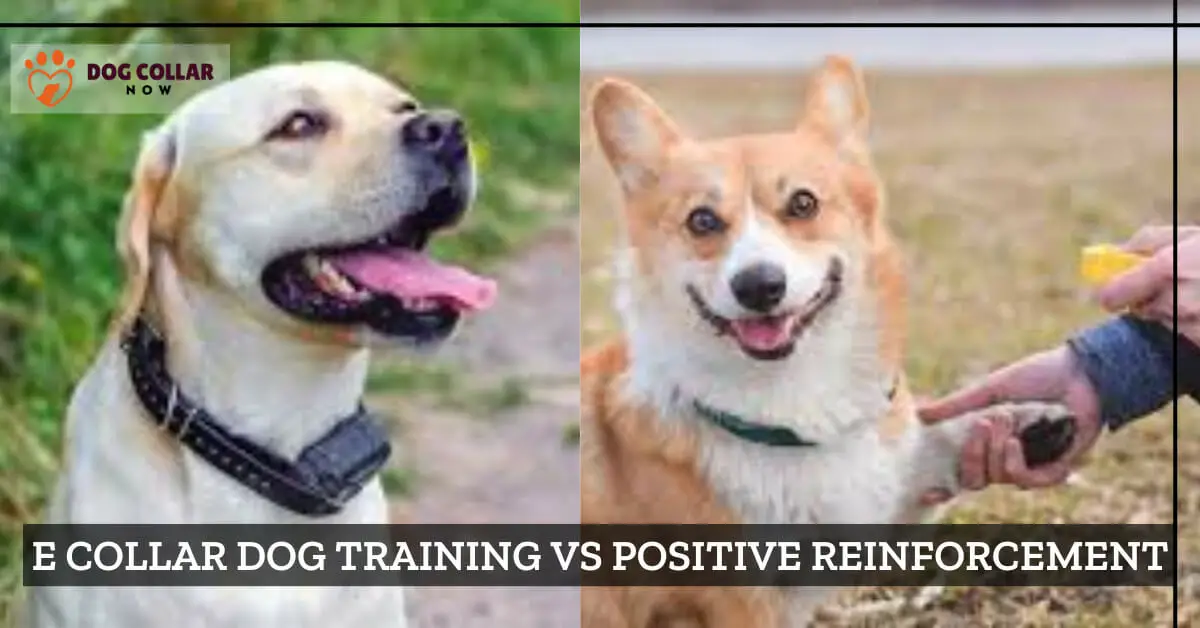E Collar Dog Training vs Positive Reinforcement – What’s Better Option

E-collar dog training and positive reinforcement are two popular methods used by dog trainers and owners to teach their furry friends obedience and good behavior.
The main difference between the e-collar, also known as a shock collar, and positive reinforcement lies in their approaches to dog training. The e-collar is a tool that administers an electric shock to discourage unwanted behavior, while positive reinforcement involves rewarding good behavior with treats, praise, and other incentives.
E-collar training and positive reinforcement training have different impacts on a dog’s behavior and relationship with its owner.
I’ll discover the E Collar Dog Training Vs Positive Reinforcement methods and their effectiveness, uncover the pros and cons of each approach, and help you make an informed decision on which method is best for your furry companion.
E Collar Dog Training Vs Positive Reinforcement – What’s The Difference Between
E-collar dog training and positive reinforcement are two vastly different approaches to dog training.
E-collar dog training or remote collar involves the use of a remote-controlled electronic collar that delivers a shock or vibration as a correction when your furry friend misbehaves, while positive reinforcement focuses on reward-based training with treats and praise.
The primary difference between these two methods is in how they motivate dogs. E-collar canine training uses negative reinforcement by punishing undesired behaviors while training with positive reinforcement emphasizes rewards for good behavior.
While e-collars can be an effective tool for some dogs, they have been criticized for being too harsh and potentially damaging to the animal’s well-being.
On the other hand, positive reinforcement has been proven to be both humane and effective in shaping desired behavior. By using treats, toys, or verbal praise as a reward system for desirable actions like sitting or staying on command, dogs learn what behaviors earn them praise from their human companions.
Ultimately, it comes down to personal preference and what works best for you and your pet’s specific needs.
1) E Collar Dog Training
Pros and Cons of e-Collar Dog Training
| Pros | Cons |
| Unleash control for effective training | Potential for abuse and misuse. |
| Corrects behavior without physical punishment. | Negative impact on mental health. |
| Adjustable stimulation levels for tailored training. | Ineffectiveness for certain breeds/personalities. |
| Accelerates learning with experienced trainers. | Requires time and patience for effectiveness. |
| Requires proper supervision and understanding. | Controversial due to potential risks. |
Types Of E Collar Dog Training
- Oversized Training: This method involves delivering a shock correction to the dog when they fail to follow commands or exhibit undesirable behaviors. It aims to establish boundaries and enforce obedience.
- Remote Training: Using a remote control, this approach allows owners to administer corrections from a distance. It is particularly useful for off-leash training, reinforcing positive behaviors, and maintaining control in various situations.
- GPS-Based Tracking: This innovative technique combines e-collar training with GPS technology. Owners can track their dog’s movements and define virtual boundaries using an electronic fence system.
- Vibration Training: Some e-collars offer vibration as an alternative to shock corrections. Vibration can be used to get the dog’s attention or serve as a milder form of correction for sensitive canines.
- Tone Training: Certain e-collars come equipped with tone or beep functions. These audible cues are used to signal the dog and reinforce desired behaviors. They can be an effective way to communicate with your furry friend without the need for physical stimulation.
- Multi-Function Collars: These advanced e collars incorporate multiple training modes, such as vibration, tone, and shock. They provide flexibility, allowing owners to choose the most appropriate training method based on their dog’s individual needs and temperament.
While e collar training techniques can be controversial, it’s important to consider the specific type of training and use them responsibly and with proper guidance.
2) Positive Reinforcement
Pros and Cons of positive reinforcement
| Pros | Cons |
| Promotes good behavior through rewards | Requires consistent and frequent rewards |
| Strengthens bond between owner and pet. | Some dogs may be unmotivated by treats. |
| Provides flexibility in training techniques. | Ineffective in high-distraction environments. |
| Works in various situations, including unleash | Does not address problem behaviors. |
| No need for fear-based punishment. | Not suitable for all dog types. |
| Increases trust and willingness to follow. | Consider potential downsides for training. |
Types Of Positive Reinforcement
- Treats or food rewards: Using delicious treats as a motivator to reward your dog’s good behavior during training sessions.
- Verbal praise: Shower your furry friend with uplifting words and a cheerful tone to acknowledge their correct actions and encourage repetition.
- Playtime with toys: Offering interactive and engaging toys as a fun reward for your dog’s achievements, providing mental stimulation and physical exercise.
- Affectionate gestures: Expressing your love through gentle petting, cuddles, and belly rubs to reinforce positive behaviors and strengthen the bond with your canine companion.
- Consistent positive reinforcement: Employing a combination of the above techniques consistently to instill good habits, promote learning, and create an enjoyable training experience for you and your furry best friend.
E Collar Dog Training Vs Positive Reinforcement – Whats The Better Option
When it comes to professional dog training, two popular methods are e-collar training and positive reinforcement. E-collar training can provide unleash control and work well for certain dogs, but it can also be harsh if not used properly.
Positive reinforcement, on the other hand, focuses on rewarding good behavior and building a bond with your pup. Both approaches have their pros and cons, so it’s important to consider your dog’s personality and needs when deciding which method to use to train your dog. Ultimately, the chosen method should prioritize your pet’s well-being and be effective in shaping their behavior positively.
What To Consider When Buying A E Collar Dog Training Vs Positive Reinforcement
Both approaches have their own merits and considerations. Let’s explore some key factors to consider when deciding between e-collar training and positive reinforcement training for your furry companion:
Training Philosophy:
E-collar training: E-collar training relies on the use of electronic stimulation to deliver corrections or cues to your dog. It emphasizes the concept of aversive conditioning, where the dog learns to avoid certain behaviours to prevent discomfort.
Positive reinforcement training: Positive reinforcement training, on the other hand, focuses on rewarding desired behaviours rather than punishing unwanted behaviours. It promotes a bond based on trust, rewards, and encouragement.
Effectiveness and Efficiency:
E-collar training: Proponents of e-collar training argue that it can provide quick and precise corrections, making it effective in certain situations. It can be particularly useful for off-leash training or in situations where immediate response is crucial.
Positive reinforcement training: Positive reinforcement training aims to create a positive association between desired behaviors and rewards, fostering long-lasting learning. It may take more time and patience, but it has been proven effective for teaching dogs a wide range of commands and behaviors.
Impact on the Dog:
E-collar training: Critics of e-collar training raise concerns about the potential for physical and emotional discomfort that the dog may experience. Improper or harsh use of e-collars can lead to fear, anxiety, or even aggression in some cases.
Positive reinforcement training: Positive reinforcement training focuses on building a strong bond and trust between you and your dog. It creates a positive and enjoyable learning experience, promoting confidence, enthusiasm, and a willingness to learn.
Ultimately, the decision between e-collar training and positive reinforcement training depends on your personal beliefs, training goals, and the specific needs and temperament of your dog.
Conclusion
The choice between e collar dog training vs positive reinforcement ultimately depends on individual preferences and the specific needs of your furry companion.
E collar training offers off-leash control but requires caution, while positive reinforcement builds a bond and encourages good behavior through rewards.
It is a versatile method that can be applied in various situations, although it may require more patience and consistency. Ultimately, the key is to prioritize your dog’s well-being and choose a training approach that aligns with their personality, needs, and your own values as a responsible pet owner.
FAQs
Is e collar dog training a humane training method?
The use of electronic collars in dog training has been a topic of debate due to concerns about its impact on dog welfare. While proponents argue that it is an effective and humane training tool in the hands of a professional dog trainer, opponents cite the potential for abuse and aversive effects on dogs.
What are the other training technique apart from e-collar dog training?
Positive reinforcement, clicker training, and other reward-based training style are the most widely used dog training methods. These methods are generally considered more humane and effective than e-collar training.
How does an e-collar work in dog training?
An e-collar is a remote training collar that delivers a shock to the dog when it exhibits undesirable behavior. The shock is aimed at stopping the behavior through negative reinforcement.
Can I train my dog with an e-collar myself?
The use of electronic collars should only be done by a professional dog trainer who has experience in using the tool.
Can e-collar training be effective in controlling aggressive behavior in dogs?
While some professional trainers in the electronic collar industry claim that e-collar training is effective in controlling aggressive behavior in dogs, there is no scientific evidence to support this claim.
What are the possible negative effects of using an e-collar in dog training?
Using an e-collar improperly or excessively can cause physical and psychological harm to the dog, including pain, fear, stress, and anxiety. Additionally, it can worsen the behavior being addressed instead of improving it.







